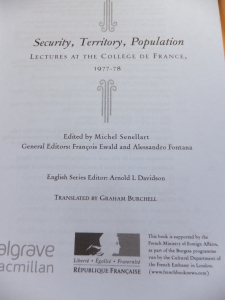I’m working my way through Richard Aldrich’s The Hidden Hand: Britain, America and Cold War Secret Intelligence(London: John Murray, 2001). This deals with the development of the covert dimensions of British and to a lesser extent American statecraft from the middle of the Second World War up until 1963. Richard Aldrich is one of the best know British academic historians of intelligence and the covert world. The story he tells directly impinges on the ‘engagement of foreign publics’ through the exploits of the International Organizations Division of the CIA and the Information Research Department of the Foreign Office but also raises broader questions about nature of modern statecraft. I’m going to reflect on this in three posts. The first deals with the origins of British and American information programmes in the post war period, the second considers the implications of this type of history for the way we think about foreign policy and the state, and finally, the nature of the relationship between overt and covert in public diplomacy.
I’ve been puzzled as to why the US developed an independent information agency and the UK didn’t. Although not specifically addressing the issue Aldrich puts this question in the broader context of how to incorporate the wartime instruments of statecraft; intelligence, covert action, psychological warfare into the postwar foreign policy organization. Anthony Eden, the wartime British Foreign Secretary, took the view that a) these organizations had caused enormous trouble for the diplomats and b) if they were going to exist in the postwar period they should under the control of the FO. His view was not universally shared within the ministry, Alexander Cadogan, the chief civil servant within the FO rejected this view noting in his diary that ‘we aren’t a department store’. He lost the argument and Eden and his successor, Ernest Bevin pushed hard to incorporate the remains of these agencies over the opposition of the agencies themselves and the armed services. While there was some support in the forces for the retention of a separate covert action service like the SOE there was also recognition of the need for better control of special operations. Indeed Aldrich points to comments in British documents of the time that praised the OSS and the benefits of uniting all covert activities in a single organization. Ironically, this end was achieved but under the control of the FO not of an independent agency. Overt and covert information activities as well as covert action came under the control of the FO. To the extent that the wartime capabilities were preserved the Foreign Office razed the organizational structures and forced any personnel to satisfy the Foreign Office that they were suitable people. In doing this the FO could draw on the fact that it had had a News Department in the pre-war period that had conducted overseas information activities and that it already controlled the Secret Intelligence Service (SIS or MI6) so had a ready made home for those that it took over from SOE or PWE.
There was a parallel debate in Washington. The Secretary of State James F. Byrnes favoured the incorporation of intelligence into State but as in the UK he was opposed by parts of his own department and by the Joint Chiefs. Truman’s position seems to have wavered before confirming the creation of the CIA as an independent agency. Despite the creation of the State Department Office of International Information and Cultural Affairs on 1 January 1946 information programmes remained a semi-detached element of State.
As tensions rose with the Soviet Union during the late 1940s they also rose with the British Chiefs of Staff who favoured a much more aggressive campaign of subversion against the Eastern Bloc. I would argue that the absorption of the remnants of the wartime agencies into the FO put it in much stronger position within the UK foreign policy establishment than State was. Another point to mention is that the British executive has much more freedom to organize itself that the American one does. While the state of the ‘overseas information services’ was a topic of parliamentary questions during the 1940s there was no scope for the kind of intervention that was mounted by Congressional Committees during the 1940s and 1950s.
Obviously this is a counterfactual but I think that if the FO hadn’t moved so rapidly to absorb the wartime organizations then by the late 1940s there would have been immense pressure to re-establish these agencies outside the FO and with a closer relationship to the military and that part of this would have incorporated at least a covert information agency. Aldrich speculates that the agreement of the FO for SIS to become involved in armed subversive activities against Albania in the late 1940s, despite doubts, was in part a strategy to buy off the pressure from the UK Chiefs of Staff. In the veterans of the wartime agencies like C.D. Jackson agitated for an information agency that wasn’t constrained by diplomats, while the elevation of John Foster Dulles to Secretary of State in 1953 saw the victory of the Cadogan ‘we’re not a department store’ line and overt information, like covert action and intelligence, were spun off into an independent agency.
Aldrich’s point is that victory of the FO in the struggles in the late 1940s meant that British foreign policy was less troubled by different agencies pursuing their own lines than the US. (Of course this didn’t mean that British policy makers were any less likely to make mistakes but that they were better coordinated while doing it!)


